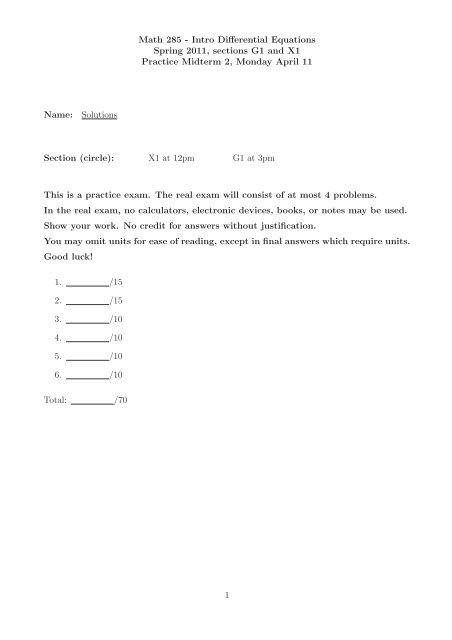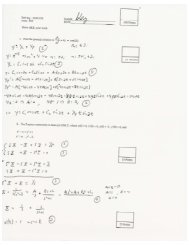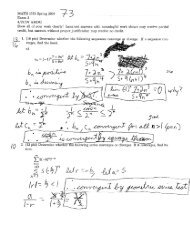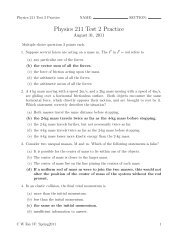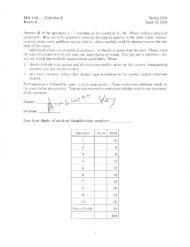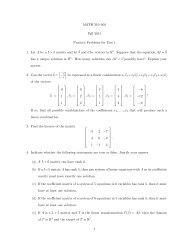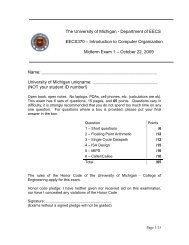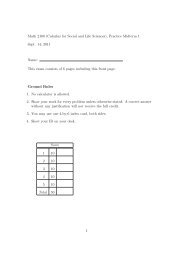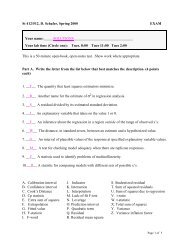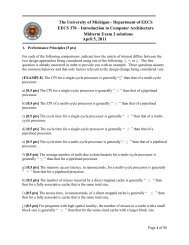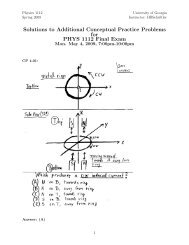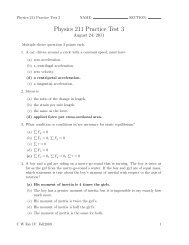Sample Exam 2 w Solutions (2011) – Differential Equations
Sample Exam 2 w Solutions (2011) – Differential Equations
Sample Exam 2 w Solutions (2011) – Differential Equations
You also want an ePaper? Increase the reach of your titles
YUMPU automatically turns print PDFs into web optimized ePapers that Google loves.
Math 285 - Intro <strong>Differential</strong> <strong>Equations</strong>Spring <strong>2011</strong>, sections G1 and X1Practice Midterm 2, Monday April 11Name: <strong>Solutions</strong>Section (circle): X1 at 12pm G1 at 3pmThis is a practice exam. The real exam will consist of at most 4 problems.In the real exam, no calculators, electronic devices, books, or notes may be used.Show your work. No credit for answers without justification.You may omit units for ease of reading, except in final answers which require units.Good luck!1. /152. /153. /104. /105. /106. /10Total: /701
y(s)LasFigure 1: Bumpy road.Problem 1a. (12 pts) A car is moving at constant speed v on a road which becomes bumpy.The equation of the surface is y(s) = asin( 2πs)= L 0.1sin(2πs ) where a = 0.1 m is the amplitude6of the bumps and L = 6 m is their wavelength (figure 1).Assume the car behaves like a mass of 1,000 kg on a spring with spring constant 100,000 N/m,without shock absorber. We want to know how the bumpy road will affect the car. Let x(t)be the upward displacement of the car, relative to its static equilibrium position <strong>–</strong> i.e. theequilibrium position once the spring has been compressed by the weight of the car.Find x(t), assuming the car was always at its vertical equilibrium position before reaching thefirst bump (at time t = 0). Assume a generic value of the speed v. Hint: The spring is stretchedby x−y and the spring force is the only force to take into account.The weight of the car is taken into account by changing the reference to the static equilibriumposition. The spring force is (effectively) k(x−y) = 100,000(x−y) and so Newton’s law appliedto the vertical position of the car yields:mx ′′ = −k(x−y)1,000x ′′ = −100,000(x−y).The horizontal position of the car is s(t) = vt, at which the elevation of the road is y(t) =0.1sin( πvt ) so the equation becomes:3(1,000x ′′ = −100,000 x−0.1sin πvt )3x ′′ = −100x+10sin πvt3x ′′ +100x = 10sin πvt3 .The homogeneous equation x ′′ +100x = 0 has a basis of solutions cos10t, sin10t. Let us finda solution of the non-homogeneous equation of the form:2
x p = Acos πvt πvt+Bsin3 3x ′ p = −A πv3πvtsin3 +Bπv πvtcos3 3x ′′p = −A( πv3 )2 cos πvt3 −B(πv 3 )2 sin πvt3x ′′p +100x p = A(100−( πv3 )2 )cos πvt3 +B(100−(πv 3 )2 )sin πvt3= 10sin πvt3{A = 0B =10100−( πv3 )2so that the solution is:10x p =100−( πv sin(πvt)2 3 ).3The general solution is x = x p +c 1 cos10t+c 2 sin10t. We find the values of c 1 and c 2 using theinitial conditions x(0) = c 1 = 0 and x ′ (0) = 0:The solution is:x ′ = πv3x ′ (0) = πv3x(t) =c 2 = − πv310100−( πv3)2cosπvt3 +10c 2cos10t10100−( πv3 )2 +10c 2 = 01100−( πv3 )2.(1100−( πv 10sin πvt3 )2 3 − πv )3 sin10t .b. (3 pts) At what speed v do resonance vibrations occur?Resonance happens when the frequency of the forcing πv is equal to the natural frequency 103(in rad/s):πv3 = 10v = 30πi.e. when the speed of the car is 30π m/s. 3
Problem 2a. (9 pts) A mass-spring-dashpot system with mass 1 kg, spring constant 4.5N/m, and damping coefficient 1 N/(m/s) is subject to an external force F(t) = 10cosωt. Findthe steady periodic solution x sp (t).The equation is x ′′ +x ′ +4.5x = 10cosωt. The steady periodic solution is the solution of thenon-homogeneousequationwhichdoesnotcontainexponentials. Wefinditusingundeterminedcoefficients:x sp = Acosωt+Bsinωtx ′ sp = −Aωsinωt+Bωcosωtx ′′sp = −Aω 2 cosωt−Bω 2 sinωtx ′′sp +x ′ sp +4.5x sp = (−Aω 2 +Bω +4.5A)cosωt+(−Bω 2 −Aω +4.5B)sinωt= 10cosωt{(4.5−ω 2 )A+ωB = 10−ωA+(4.5−ω 2 )B = 0[ ][ ] [ ]4.5−ω2ω A 10−ω 4.5−ω 2 =B 0[ [ ] A 4.5−ω2 −1 [ ]ω 10=B]−ω 4.5−ω 2 0[ ][ ]1 4.5−ω2−ω 10=(4.5−ω 2 ) 2 +ω 2 ω 4.5−ω 2 0[ ]10 4.5−ω2=.(4.5−ω 2 ) 2 +ω 2 ωThe steady periodic solution is:x sp (t) =10(4.5−ω 2 ) 2 +ω 2 ((4.5−ω 2 )cosωt+ωsinωt ) .4
. (6 pts) Determine whether practical resonance can occur. If so, at what frequency (inHertz), and what is the (maximal) amplitude of the steady periodic solution then?The amplitude of the steady periodic solution is:C(ω) ==10(4.5−ω 2 ) 2 +ω 2 √(4.5−ω2 ) 2 +ω 210√(4.5−ω2 ) 2 +ω 2.C(ω) is maximal if and only if the radicand g(ω) := (4.5 − ω 2 ) 2 + ω 2 of the denominator isminimal:g(ω) = 4.5 2 −9ω 2 +ω 4 +ω 2= ω 4 −8ω 2 +4.5 2dgdω = 4ω3 −16ω= 4ω(ω 2 −4)= 4ω(ω +2)(ω −2).The three critical points ω = −2,0,2 of g are respectively a local minimum, maximum, andminimum. Therefore C(ω) has a (global) maximal at ω max = 2 rad/s = 2 = 1 Hz. The2π πmaximal amplitude is:C(2) =10√(4.5−4)2 +4= √10174= 20 √17meters.5
Problem 3a. (2 pts) Check that y 1 (x) = x+1 and y 2 (x) = e x are solutions of the equation:xy ′′ −(x+1)y ′ +y = 0.xy ′′1 −(x+1)y ′ 1 +y 1 = x(0)−(x+1)(1)+(x+1) = 0xy ′′2 −(x+1)y ′ 2 +y 2 = x(e x )−(x+1)(e x )+(e x )= e x (x−(x+1)+1) = 0.b. (7 pts) Find a particular solution y p (x) of the equation:xy ′′ −(x+1)y ′ +y = x 2 .We use variation of parameters. Let us first compute the Wronskian:∣ W(y 1 ,y 2 ) =x+1 ex ∣∣∣∣ 1 e x∣ ∣∣∣= e x x+1 11 1∣= xe x .Assuming x ≠ 0, the equation is y ′′ − x+1x y′ + 1 x y = x. Let us find a solution y p = u 1 y 1 +u 2 y 2 :u ′ 1 = − y 2xW(y 1 ,y 2 )= − xexxe x= −1∫u 1 = −1dx = −x.u ′ 2 =y 1 xW(y 1 ,y 2 )= x(x+1)xe x= (x+1)e −x∫u 2 = (x+1)e −x dx∫= (x+1)(−e −x )+e −x dx= −(x+1)e −x −e −x= −(x+2)e −xy p = u 1 y 1 +u 2 y 2= −x(x+1)−(x+2)e −x e x= −x 2 −2x−2= −x 2 −2(x+1) = −x 2 −2y 1 .6
Let us check that y(x) = −x 2 is indeed a solution of the non-homogeneous equation (for allx ∈ R):x(−2)−(x+1)(−2x)+(−x 2 ) = −2x+2x 2 +2x−x 2= x 2 .c. (1 pt) Find the general solution of the equation in (b).By (a) and (b), the general solution is y(x) = −x 2 +c 1 (x+1)+c 2 e x , c 1 ,c 2 ∈ R.7
Problem 4a. (8 pts) Find a periodic solution of the equation x ′′ +5x = f(t) where f(t) = ton the interval −π < t < π and f is 2π-periodic. You can express the answer in exact form oras a Fourier series <strong>–</strong> or both, for practice.Exact solution. The associated homogeneous equation x ′′ +5x = 0 has a basis of solutionscos √ 5t, sin √ 5t. On the interval (−π,π), the non-homogeneous equation has a solution x p =Ax + B = 1 5 t. The general solution on that interval is x(t) = 1 5 t + c 1cos √ 5t + c 2 sin √ 5t. A2π-periodic solution is found by imposing the endpoint conditions:x(−π) = x(π)x ′ (−π) = x ′ (π)and extending the solution periodically. We find the values of c 1 and c 2 :− π 5 +c 1cos(− √ 5π)+c 2 sin(− √ 5π) = π 5 +c 1cos √ 5π +c 2 sin √ 5π2c 2 sin √ 5π = − 2π 5πc 2 = −5sin √ 5πx ′ = 1 5 −√ 5c 1 sin √ 5t+ √ 5c 2 cos √ 5t15 −√ 5c 1 sin(− √ 5π)+ √ 5c 2 cos(− √ 5π) = 1 5 −√ 5c 1 sin √ 5π + √ 5c 2 cos √ 5π√5c1 sin(− √ 5π) = − √ 5c 1 sin √ 5πThe solution is:x(t) = t 5 −c 1 = 0.π5sin √ 5π sin√ 5t (1)on the interval (−π,π), and extended 2π-periodically to obtain a (periodic) solution defined forall x ∈ R.Fourier series solution. Let us first find the Fourier series of f(t). Since f is odd, there areonly sine terms f(t) = ∑ ∞n=1 B nsinnt:B n = 2 π∫ π0= − 2πntsinntdt( ∫ π)[tcosnt] π 0 − cosntdt0= − 2πn πcosnπ= 2(−1)n+1 .n8
We find a formal Fourier series solution x(t):x = a ∞02 + ∑a n cosnt+b n sinntx ′ =x ′′ =1∞∑−na n sinnt+nb n cosntn=1∞∑−n 2 a n cosnt−n 2 b n sinntn=1x ′′ +5x = 5a ∞02 + ∑(5−n 2 )a n cosnt+(5−n 2 )b n sinnt= f(t) =n=1∞∑ 2(−1) n+1sinntnn=1⇒ a n = 0 for all nb n = 2(−1)n+1n(5−n 2 ) = 2(−1)nn(n 2 −5) .The periodic solution is:x sp (t) = 2∞∑n=1(−1) nsinnt. (2)n(n 2 −5)Just for fun. Check that (2) is indeed the Fourier series of (1).b. (2 pts) Find all possible initial conditions x(0), x ′ (0) such that the solution to the aboveequation is periodic. Explain.The general solution of the equation is:x(t) = x sp (t)+c 1 cos √ 5t+c 2 sin √ 5t= x sp (t)+Ccos( √ 5t−α).The first term is 2π-periodic whereas the second term is 2π √5-periodic. Since the two periodshave an irrational ratio, the only way the sum can be periodic is if the second term is zero,i.e. c 1 = c 2 = 0. In other words, x sp is the only periodic solution. The corresponding initialconditions are:x(0) = x sp (0) = 0x ′ (0) = x ′ sp(0) = 1 5 −π√5sin√5πusing (1)= 2∞∑n=1(−1) nn 2 −5using (2).9
Problem 5. (10 pts) A piece with mass m inside a mechanical device is moving along anaxis and is subject to a force f(t), where f(t) = 23|t| (in Newtons) for −2 ≤ t ≤ 2 and fis periodic with period 4 s. The piece is also constrained by what is effectively a spring withspring constant 10 N/m. Friction is negligeable.Find all values of the mass m such that the piece could enter into resonance.The natural frequency of the piece is ω 0 =√10mrad/s. The piece can enter into resonance ifand only if ω 0 is also a frequency of the external force f(t). Let us find those frequencies bycomputing the Fourier series of f(t) (or rather |t| since a constant factor doesn’t change thefrequencies). Note that |t| is even, so there are no sine terms:|t| = A ∞02 + ∑A n = 2 2= 2nπ∫ 20n=1A n cos nπt2tcos nπt2 dt([tsin nπt2 ]2 0 −= ( 2nπ )2 [cos nπt2 ]2 0= ( 2nπ )2 ((−1) n −1){0, n even=−2( 2nπ )2 , n odd.∫ 20sin nπt2 dt )The frequencies in f(t) are therefore ω n = nπ 2for the following values of m:for all odd integers n > 0. Resonance can happenω 0 = ω nwhere n is an odd integer.√10m = nπ 210m = (nπ 2 )2 = n2 π 24m = 40n 2 π kg 210
Problem 6. (10 pts) Find all eigenvalues and corresponding eigenfunctions y(x) of theproblem:y ′′ +λy = 0y ′ (−1) = 0, y ′ (1) = 0.Case λ < 0, say λ = −α 2 for some α > 0. The equation y ′′ −α 2 y = 0 has a general solution:y = c 1 e αx +c 2 e −αxy ′ = αc 1 e αx −αc 2 e −αxy ′ (−1) = αc 1 e −α −αc 2 e α = 0y ′ (1) = αc 1 e α −αc 2 e −α = 0∣ ∣ e−α −e α ∣∣∣e α −e −α = −e −2α +e 2α ≠ 0⇒c 1 = c 2 = 0.Only the trivial solution, so λ is not an eigenvalue.Case λ = 0. The equation y ′′ = 0 has a general solution:y = c 1 +c 2 xy ′ = c 2y ′ (−1) = c 2 = 0y ′ (1) = c 2 = 0and there is no constraint on c 1 . That means λ = 0 is an eigenvalue, with eigenfunctiony 0 (x) ≡ 1.Case λ > 0, say λ = α 2 for some α > 0. The equation y ′′ +α 2 y = 0 has a general solution:y = c 1 cosαx+c 2 sinαxy ′ = −αc 1 sinαx+αc 2 cosαxy ′ (−1) = −αc 1 sin(−α)+αc 2 cos(−α) = 0y ′ (1) = −αc 1 sinα+αc 2 cosα = 0sinα ∣−sinα cosα∣ = 2sinαcosα= sin2α.There are non trivial solutions if and only if the following holds:sin2α = 02α = nπ for some integer nα = nπ 211
[ ]c1in which case =c 2[ ] cosαspans all solutions for csinα1 , c 2 .The positive eigenvalues are λ n = αn 2 = ( )nπ 22 with eigenfunctions yn (x) = cosαcosαx +sinαsinαx which are, up to sign:{cos nπx,n even 2sin nπx,n odd. 212


